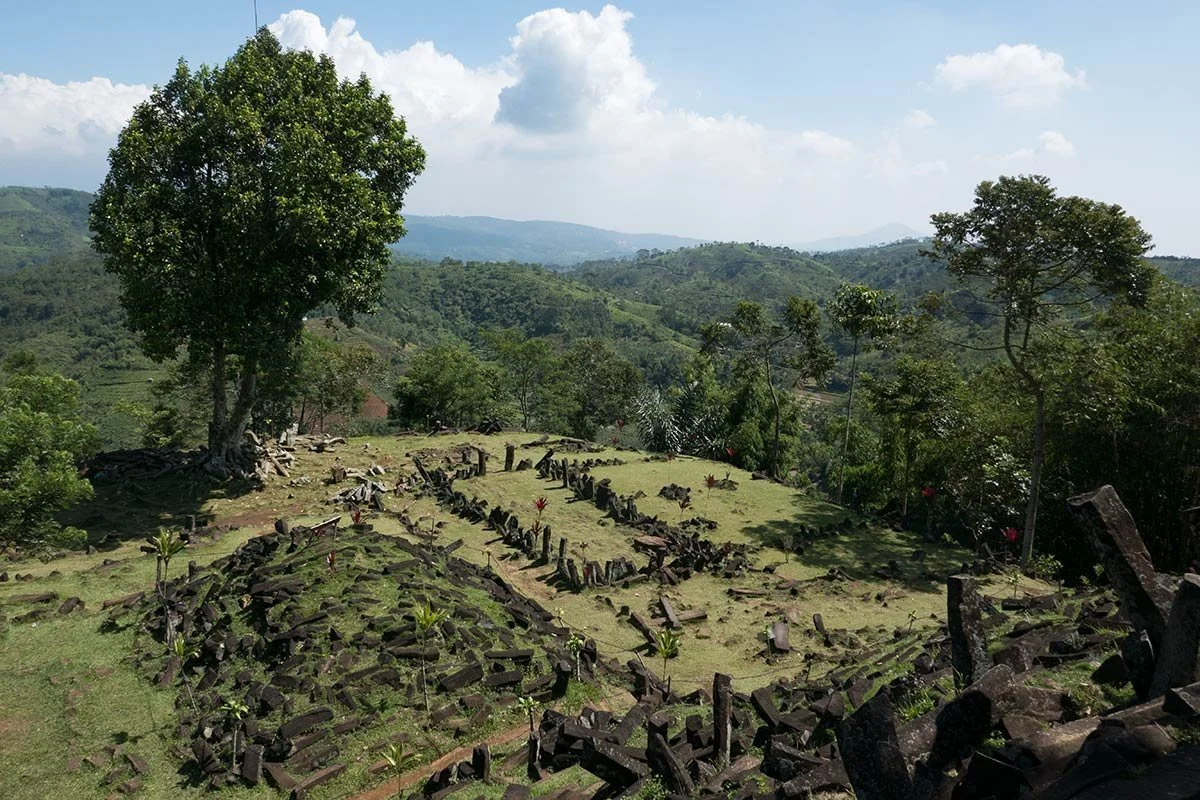What's So Grand About Gunung Padang?
/Gunung Padang (Mountain of Enlightenment) is a remote site of mysterious man-made ruins within and atop a mountain in western Java, Indonesia. The megalithic site is a National Cultural Reserve located near the village of Cianjur Regency. It’s comprised of up to 50,000 hexagonal columnar blocks of basalt, quarried from elsewhere and transported here. Each one weighs about a third of a ton or about 650 lbs. The columnar blocks not only blanket top of the hill but wrap around the hill in multiple terraces covering area of 37 acres.
Typical basalt formation in situ would be vertical formation but the formation of the wrap around portion at Gunung Padang form terraces in horizontal formation with a consistent application of five centimeters of mortar denoting it as man made construction. The entire site is much more than a hill, it's a five-terrace step pyramid with rings of basalt at multiple levels in a rounded shape instead of the angular shape of pyramids in Egypt, Mexico, Peru and other places.
Archeologist Ali Akbar, University of Indonesia, did a comprehensive site investigation, digging in a few isolated trenches and only a few feet in depth, beginning in 2012 finding two cultural layers. the first one dating to 500 BC. The second cultural layer, found at 4 meters deep, tested to 5,200 BC. No skeleton or human bone found at this layer.
Dr. Danny Hilman Natawidjaja, Geologist and his team applied geological scientific techniques for further investigation. This yielded more layers and older dates. Their findings were published.
The scientific, peer-reviewed investigations undertaken by Dr. Natawidjaja and his team of geologists in the last 15 years are hotly contested by many archeologists who are unconvinced of what the science shows. These investigations incorporated an integrated multi-method series of surveys conducted for three years from November 2011 to October 2014 and included a combination of detailed landscape and surface mapping, core drillings, trenching and integrated geophysical techniques involving two-dimensional (2D) and three-dimensional (3D) electrical resistivity tomography (ERT), ground penetrating radar (GPR) and seismic tomography (ST). These multiple methods allowed for cross-validation and enhanced interpretation of subsurface structures.
Applying these geological techniques allowed for a much more wide-reaching investigation covering more ground and going deeper. Initially GPR was used at 40 mhz to 30 meters in depth.
Seismic tomography revealed three large rectangular chambers, one about 10 meters down perhaps an initial entrance area. It appears to connect to an access tunnel leading to to a larger main chamber. This in turn connects to a third chamber at a depth of 20-30 meters. All three chambers and connecting tunnels align to the central access of the site. (See screenshot below.)
To refine the dating of the site through the different layers, the geologists applied core drilling. As expected the cores of the top two layers dated to 1,000 BC to 6,000 BC (2,000 years ago to 8,000 years ago). But when they drilled to 15 meters, around 50 feet, those cores tested to 9,600 BC (11,600 years ago).
Drilling deeper, to what is believed to be the earliest layer (layer 4) of construction at about 30 meters, or about 100 feet, the dating came back as possibly being older than 22,000 BC (24,000 years ago).
Generally, archeologists contend that no large-scale structures were made until about 4,000 years ago. Back then, Java wasn't an island but the southern region of the Sundaland continent. With the ensuing ocean rise of 400 ft over the last 20,000 years, today this leaves just the highlands of Malaysia and Indonesia with what was once the lowlands being consumed with ocean water now.
Keep reading for our brief layman's summary on the science and controversy. We visited here March 17, 2024 on a one day transportation service offered by bogorprivatetourguide.com. (Driver did not ascend mountain with us. Non-English speaking guides were onsite,) We were coming from Yogyakarta by train to Bandung. Our driver picked us up at our Bandung hotel in the morning. After our visit, he dropped us at our hotel in Bogor. Lots of driving but doable in one day and worth it. The Bogor location positioned us nicely for easy 90 minute train travel to central Jakarta for a couple days and onward travel from the Jakarta airport.
Screenshot from graham hancock’s ancient apocalypse on netflix depicting the approximation of the underground chambers and pathways as deduced from the findings of the ert, gpr and st geophysical testing.
The Controversy
On October 20, 2023, the technical journal Archaeological Prospection published the peer-reviewed paper entitled “Geoarchaeological Prospecting of Gunung Padang Buried Pre-Historic Pyramid in West Java, Indonesia,” published by Wiley Publishing. Authors were Danny Hilman Natawidjaja, et al.
Because of anonymously submitted objections an unusual formal post-publication review of the scientific findings was undertaken. Instead of requiring minor corrections or clarifications to address legitimate points raised by the objectors, the paper was surprisingly retracted by the publisher on January 31, 2024. For more, see The Unjust Retraction of Groundbreaking Research: A Call for Academic Integrity - Graham Hancock Official Website https://grahamhancock.com/natawidjajadh1/






























We like the UnchartedX video above and watched it a couple times before our visit.
Also, if you have access to Netflix, we recommend episode one of Graham Hancock’s series called Ancient Apocalypse. It’s all about Gunung Padang, including meeting the lead geologist on the investigative team.
Some history of the site (reference):
The Gunung Padang Megalithic Site is a historical site that is 10,000 years old. The first discovery of this mountain site was published in the Rapporten van de Oudheidkundige Dienst (ROD, "Bulletin of the Antiquities Service") in 1914. However, the site was forgotten for many years. Until 1979, several local residents discovered the existence of a pile of large square stones, which then began to be researched by the National Archaeological Research Center, Bandung Archaeological Center.
The site size is about 3 hectares, the largest terraced punden complex in Southeast Asia. Punden refers to a stepped pyramid with terraces that slowly move towards its peak. The location of the site has steep hills, is difficult to reach, and has many large square-shaped andesite stones, making local residents consider this site a sacred place.
The name Gunung Padang comes from Nagara Siang Padang. The meaning of Padang in Sundanese is light or light. Local people connect the name Gunung Padang with Jabal Nur in Saudi Arabia which has the same meaning, namely a shining mountain.
The Gunung Padang Megalithic Site has its own charm, and is related to the number five. The attraction consists of five terraces, surrounded by five hills, facing five mountains, each rock has five sides, with beautiful natural views and local cultural sites.
According to stories passed down from generation to generation by local residents, the punden terraces with five terraces contain a very deep meaning.
Core 1
On this core 1, there is something called Eyang Pembuka Lawang. In this core, there are two large menhirs of which now only one is still standing. Philosophically, it is used as a symbol of opening and preparing the heart before entering the area of worship. Then there is one called Gunung Masigit/ Mosque, where there are two menhirs that are tilted like people prostrating. The direction of prostration is towards Mount Gede.
Core 2
Terrace 2 is called the Crown of the World. On this site, many people are greeted with understanding, because people meditate and repent at this place to ask for something, for example wealth.
Even though it's actually not like that. The World Crown is actually a symbol of world honor, which means why do we have abundant wealth if we don't share it with other people. Because at the World Crown there is a stone called Lumbung Stone, a symbol of mutual sharing.
Core 3
On this terrace, there is a stone called the Kujang Palm. The kujang is an heirloom weapon of the Sundanese people. The stone is right in the center of the Gunung Padang Site. In ancient times the stone stood, but now it has collapsed.
The name of the Kujang heritage weapon comes from the word ku-ujang, which means by you. Therefore, the meaning and significance of Mount Padang must be held firmly by ourselves.
Core 4
On this terrace, there is a Kanuragan Stone/Testing Stone with a symbol of strength. Many people think that if they succeed in lifting the stone their prayers will be answered, but that is a wrong understanding. The basic reason why Kanuragan Stone is located on the 4th terrace means that you are welcome to continue your journey to the fifth or highest level, as long as you are able to climb to reach the previous levels.
Core 5
On terrace 5, there is a place that is like a king's throne. It is said that local residents believe that the throne is the King of Siliwangi's throne, which functions as a resting place with a peaceful atmosphere.
Regarding the orientation of the Mount Padang site that leads to Mount Gede, it has a deep spiritual meaning because that place was a place of worship and gathering of people in the past. Whereas in ancient times, Mount Gede was considered a symbol of the Qibla facing the worship of the Almighty.









